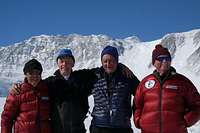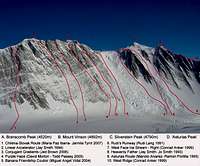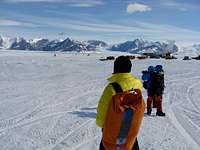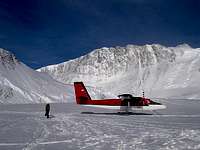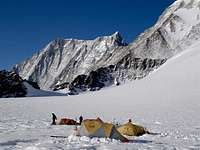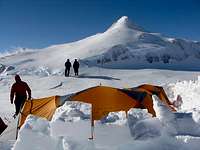-
 48140 Hits
48140 Hits
-
 93.77% Score
93.77% Score
-
 44 Votes
44 Votes
|
|
Mountain/Rock |
|---|---|
|
|
78.52556°S / 85.61714°W |
|
|
Mountaineering |
|
|
Summer |
|
|
16050 ft / 4892 m |
|
|
Overview
Mount Vinson (4892m / 16,045ft) is the highest peak in Antarctica, situated in the Sentinel Range of the Ellsworth Mountains. The Ellsworth Mountains are around 300km long and run roughly NNW-SSE. The higher northern section is the Sentinel Range, whereas the lower southern section - demarcated by the Minnesota Glacier - is known as the Heritage Range. Mount Vinson itself is approximately 1285m north of the South Pole.
Name
Vinson was named for US Senator Carl G. Vinson of Georgia, who was a strong supporter of US activity in Antarctica during the mid-20th Century. In fact the name 'Vinson' was already being proposed for the highest mountain in Antarctica even before explorers had found the mountain!
Mount Vinson vs. Vinson Massif? - For many years the correct name for Antarctica's highest mountain was Vinson Massif, due to its large bulk and numerous summits. There was no such thing as 'Mount Vinson', despite the increasingly common usage of this name, mostly by commercial expedition operators. In 2006, after several recent climbing and GPS mapping expeditions to the Sentinel Range, it was suggested to the Antarctic Place Names Committee of the USGS that the name 'Mount Vinson' be added to the database to specifically denote the highest summit of the Vinson Massif. This was accepted and 'Mount Vinson' officially came into being.
However you call it, Vinson is a big, cold mountain way out in the middle of nowhere near the bottom of the world. Though not technically hard to climb, it is very cold, very windy, and just high enough for you to get hit by the altitude.
History
1966 - First Ascent
A very small portion of the northern end of the Ellsworth Mountains was seen from the air by US aviator Lincoln Ellsworth in 1935, but the Vinson Massif was not actually discovered until the summer of 1958-59, during a tractor-train mapping survey from Byrd Station. No climbing was done in the Ellsworths until December 1961, when US scientists Tom Bastien and John Splettstoesser visited the area and climbed Mount Wyatt Earp (2370m) in the far northern end of the Sentinel Range. Some more exploration was made around the Union Glacier and nearby areas in the 1963-64 summer but no significant climbs were made.
Around this time various groups were scheming to get to Vinson, but it was not until 1966 that the US authorities sought to forestall any private attempts and support one official expedition, whose success would deter any more suitors. California lawyer Nick Clinch, who had led the 1958 first ascent of Hidden Peak (8068m) and the 1960 first ascent of Masherbrum (7821m) was brought in to lead nine other American climbers, with support from the American Alpine Club and National Geographic. The climbers were flown to New Zealand, from where they reached McMurdo station on Ross Island, then via Byrd Station, they landed on the ice west of Vinson on December 8th.
After establishing a camp, using a snow machine for support, and spying a route through a small col between Mount Shinn and Knutzen Peak, the team ascended through this notch - 'Sam's Col' - and found themselves in the upper Branscomb Glacier. After establishing another two camps on the mountain Barry Corbet, John Evans, Bill Long and Pete Schoening reached the summit on December 18th 1966. Over the following days the remainder of the team also climbed to the summit.
In the weeks following, various member of the team also made the first ascents of Mount Shinn (4660m), Mount Gardner (4587m), Long Gables (4059m), Mount Ostenso (4085m) and Mount Tyree (4852m), with the latter climb being by far the hardest ascent of the trip. In terms of exploratory mountaineering, the American Antarctic Mountaineering Expedition can be seen as one of the most successful and significant expeditions in history.
1979 - Second Ascent
Under the leadership of geologist Campbell Craddock, the USAP was operating near the Sentinel Range this season. Invited to participate in the program were Werner Buggisch and Peter von Gizycki from West Germany and Victor Samsonov from the Soviet Union. Though they were expressly forbidden by Craddock and the US authorities from any summit climbing in the range, the trio could not resist the temptation and climbed Vinson on December 22nd 1979, following the 1966 American route. Samsonov's ski pole was left on the summit and lasted until the 2006-07 season. The placing of a red flag on this pole enabled a USGS mapping team out on the ice to the southeast to fix a more accurate position for Vinson and obtain a new height of 4,897m (with a margin of error of 5m). The previously estimated height of 5,140m was dismissed, though it lasted for decades on some maps.
1983 - Third Ascent
US millionaire businessmen Dick Bass and Frank Wells instigated the concept of climbing the Seven Summits - the highest mountain on each continent - and for Vinson used their resources to build a unique team. They invited renowned British climber Sir Chris Bonington to join them, filmed by Rick Ridgeway and Steve Marts, with some Japanese climbers thrown in to help pay the bill. They were flown by the experienced British polar pilot Giles Kershaw and with assistance from the Chilean government, for fuel caches down the Antarctic Peninsula, reached Vinson in November. Bonington summited first, Bass, Wells and the others a week later.
1985
Canadian climber Pat Morrow was also on a Seven Summits quest and had been planning a Vinson trip since 1984. In that year an attempt from Ushuaia, Argentina, failed before reaching Antarctica, but in November 1985, again flown by Kershaw, Morrow's group reached the Ellsworth Mountains and summited Vinson on November 19th. In the following years Morrow and Kershaw capitalised on their experience and formed Adventure Network International (ANI), which transported hundreds of Vinson climbers and other Antarctic adventurers all over the continent. In 2003 ANI was bought by Antarctic Logistics and Expeditions (ALE).
1988
First Female Ascent - Lisa Densmore (USA)
First Solo Ascent - Vern Tejas (USA)
1989
First ascent of the rib at the far northern end of the west face now taken by the standard route - Geoff Tabin et al (USA)
1991
First ascent of a direct route on the west face - Rudi Lang (Ger), solo.
1992
First ascent of south face of Vinson Massif - Robert Anderson (USA)
1993
ANI moves base camp from old location on flat ice SW of Mt Epperly to new location in lower Branscomb Glacier.
1997
First ascent of west ridge of Vinson Massif - Conrad Anker (USA)
2000
First ascent of east face of Vinson Massif - John Armstrong, Conrad Anker, Liesl Clark, Dave Hahn, Jon Krakauer, Andrew McLean, Rob Raker and Dan Stone (USA).
2004
New GPS height of 4892m measured for Vinson by the Omega Foundation of Rodrigo Fica, Damien Gildea and Camilo Rada. This team also made the first ascents of many sub-peaks on the Vinson summit plateau.
2006
ALE fixes the first ropes up the broad rib at the northern end of the west face, changing the standard route from the previous 'headwall' route used since 1966.
New 1:50,000 color topographical map Vinson Massif & The Sentinel Range produced by the Omega Foundation
Getting There
The only reasonable way currently to get to Vinson is with ALE / ANI
ALE operates from Punta Arenas in the far south of Chile, the Magallanes region. Punta is well serviced by regular commercial flights from Santiago.
From Punta Arenas ALE operate an Ilyushin-76 aircraft which takes around four and a half hours to reach their camp at Union Glacier, in the southern Ellsworth Mountains. The ALE camp has impressive dining, medical and preparation facilities. Climbers erect and sleep in their own tents but eat in the ALE dining tent. Luxury!
Red Tape
Whether you go with a commercial guiding company or directly with ALE, you will have a ream of forms to fill out prior to your trip. These must be submitted as soon as possible - not when you arrive in Punta Arenas!
ALE has undergone rigorous preparation, planning and auditing, overseen by the US EPA and other authorities, to operate legally and safely in Antarctica. They have covered a lot of the red-tape for you and your guides.
You will need a valid passport and ALE may require specific medical information for you to join one of the Vinson programs.
Camping
Vinson is normally climbed with two camps above Base Camp.
Base Camp (2100m) is on the lower Branscomb Glacier, a great location accessed by a 50 minute Twin Otter flight from ALE's Union Glacier camp.
Low Camp (2800m) is further up the Branscomb Glacier, near the northern end of the west face of Vinson. The fixed ropes up the rib start not far beyond camp.
High Camp (3775m) is situated on a mostly flat spot at the top of the west face of Vinson, at the northwestern edge of the vast cwm leading up to Vinson's summit.
Guiding & Logistics
Antarctic Logistics & Expeditions - ALE, which also incorporates ANI, are the sole logistics operator for Vinson and the Ellsworth Mountains. All commercial guiding companies offering Vinson expeditions use the services of ALE.
Experienced and reputable commercial operators of Vinson climbs include:
IMG - Phil Ershler and his colleagues at IMG (USA) are some of the most experienced on the mountain.
Alpine Ascents International - AA (USA) usually have the most climbers on the mountain during the season and feature some very experienced guides, such as Vern Tejas.
Adventure Consultants - AC (NZ) are a very experienced and professional operator who employ some top-quality guides of impressive experience. The founders of Adventure Consultants, the late Rob Hall and Gary Ball, were instrumental in generating business in the early days of ANI.
Jagged Globe - JG (UK) are one of the world's leading operators of commercially guided mountaineering expeditions and have a long history on Vinson.
RMI - Another long-time operator on the mountain, RMI (USA) lead guide Dave Hahn recently racked up his 30th ascent of Vinson.
Note: I do not work for any of these companies nor do I have any financial interest in any of them. Their inclusion here and my comments are based on experience over more than a decade.
Research & References
Mountaineering In Antarctica: Climbing In The Frozen South - Damien Gildea.
Climbing The Seven Summits - a good book by experienced guide Mike Hamill. Lots of practical info and relatively up-to-date.
Seven Summits - Steve Bell. The first guidebook to the Seven Summits, now a little out of date. Bell is the founder and owner of Jagged Globe.
Hall & Ball - Kiwi Mountaineers - Colin Monteath. An excellent book with an interesting section on the early days of guiding on Vinson.
American Alpine Journal - the extensive free online archives of the AAJ contain numerous Antarctic / Vinson reports, particularly from the last decade.


